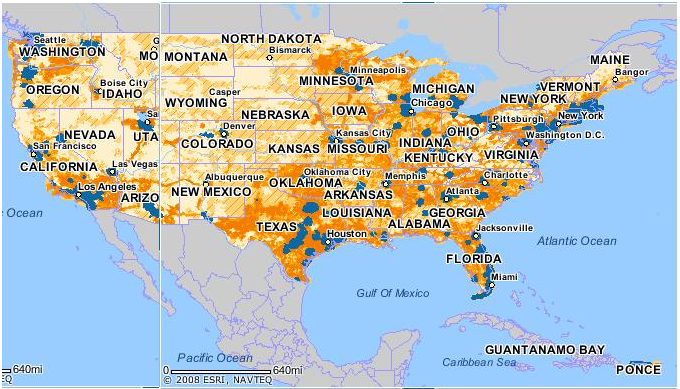by: Jason Mick

The coverage map of AT&T 3G voice coverage shows the scant covered areas in blue, with orange representing AT&T's older EDGE network.
The iPhone is soon to be feature 3G, but does your local AT&T network?
There's much excitement surrounding the launch of Apple's new 3G iPhone. The new phone brings many wish list features like 3G, improved battery life on older EDGE networks, GPS, push email, simulated multi-programs, more applications (including better Microsoft Office integration), and a lower price tag. Despite the phone's shortcomings -- no copy-and-paste, unsatisfactory storage for some users, and no video, among other things -- the phone seems poised to be another hit for Apple.
However, recent reports about the iPhone are sending uneasy murmurs through the online community. It has been suggested that the iPhone 3G's new speed boost may be inaccessible to many users, as AT&T still has a relatively small coverage area for 3G. This would leave customers paying increased rates for the same older service.
While the country's major cities and most populous areas see "blue", or 3G, in a coverage map created by blogger Christopher Spera of Gear Diary, based on AT&T metrics, more of the country is uncovered.
"If you live in one of these uncovered areas and already have an iPhone, I wouldn’t jump on the iPhone 3G wagon,” wrote Spera. “I’d stick with my current iPhone (WITH my grandfathered data plan) and save $200-$300 bucks."
Spera points to the fact that Apple's new 3G phones' data plans cost $10 more a month due to the 3G access -- whether you have coverage or not. Customers sticking with their old phones will continue to pay the same rate under grandfather clauses.
AT&T and Apple supporters were quick to point to holes in the claims. Scott McNulty of The Unofficial Apple Weblog (TUAW) pointed out that Spera's maps were for voice coverage, not data and that the coverage areas differ slightly. Secondly, he points out that Spera's maps were generated March 31, 2008. This was before AT&T's spring expansion of its 3G networks, which will bring the service to 275 new markets according to AT&T.
Tools are provided by AT&T that can be used by curious customers to compare 3G data and voice coverage areas. While Apple supporters gripe, the two forms of coverage in most areas are remarkably similar, with some minor exceptions.
The news site Apple 2.0 provides a list of cities with coverage. Further, you can use the AT&T coverage tool found here to view more detailed information.
Apple and AT&T previously said that they do not guarantee 3G coverage in any area, even the ones that are said to be covered. They say that radio interference and tall buildings can instantly kill the signals -- factors which they consider too complex to consider.
It appears that the coverage for 3G iPhone buyers will be slightly better than Spera's cautionary predictions -- but not by much. The varying coverage simply gives customers one more thing to pause and consider when adopting the new iPhone.


